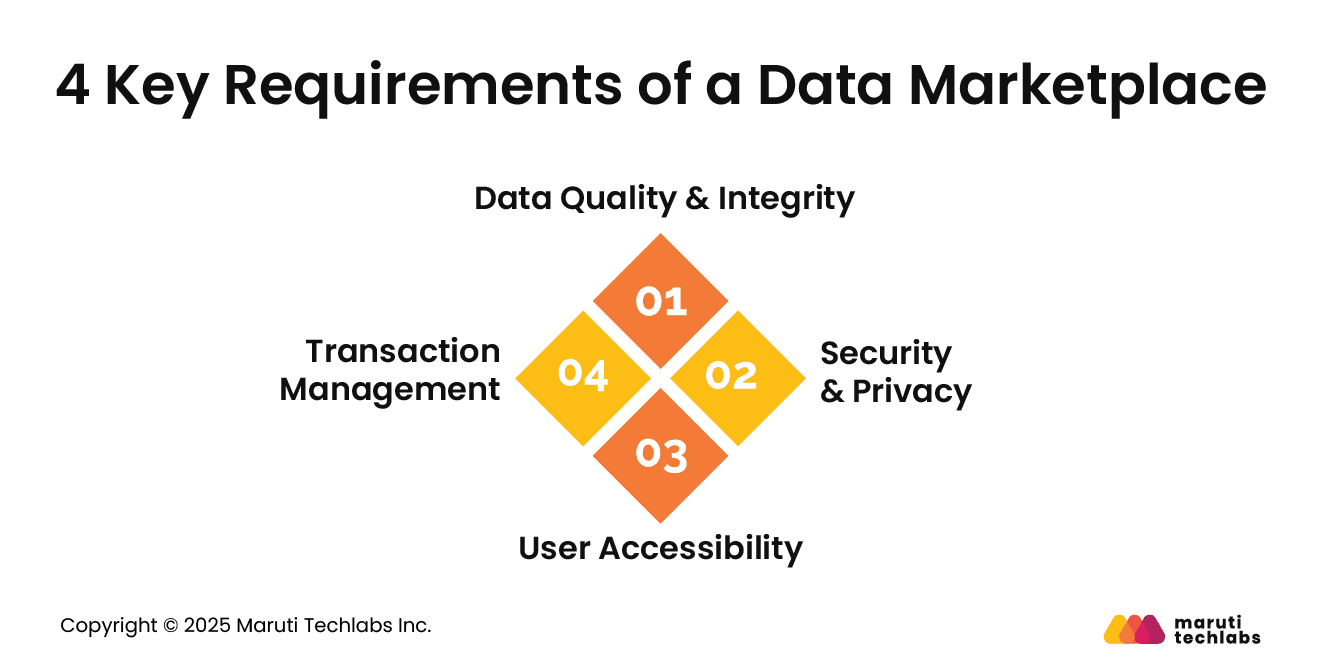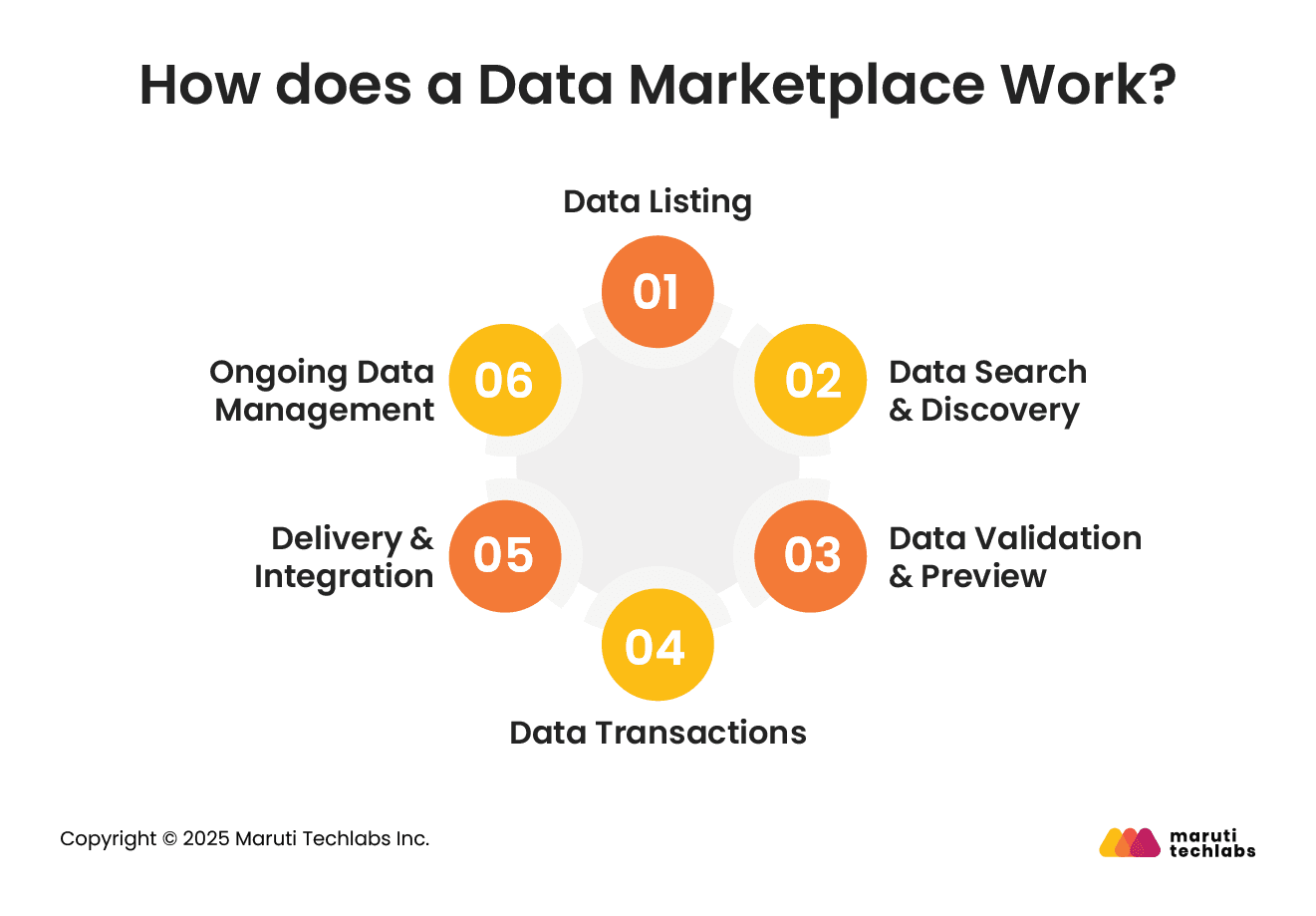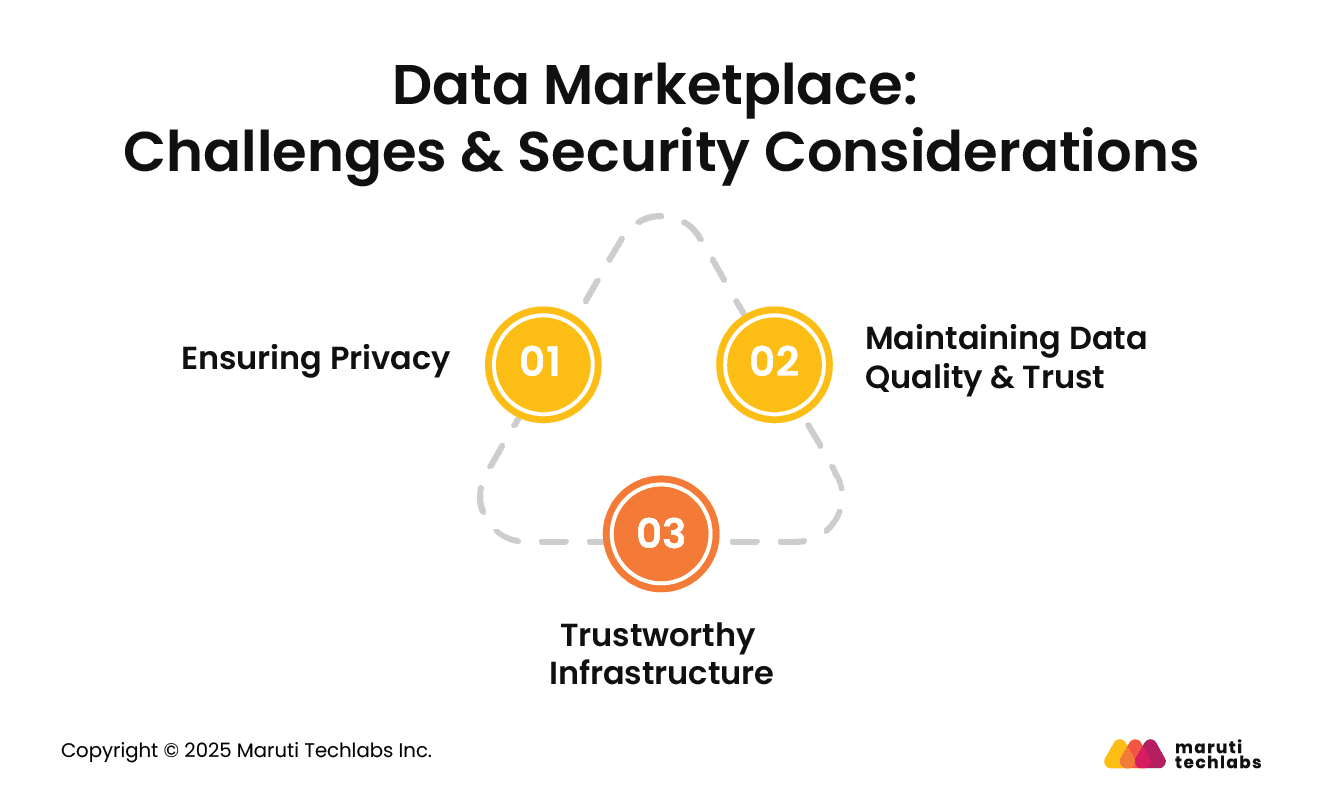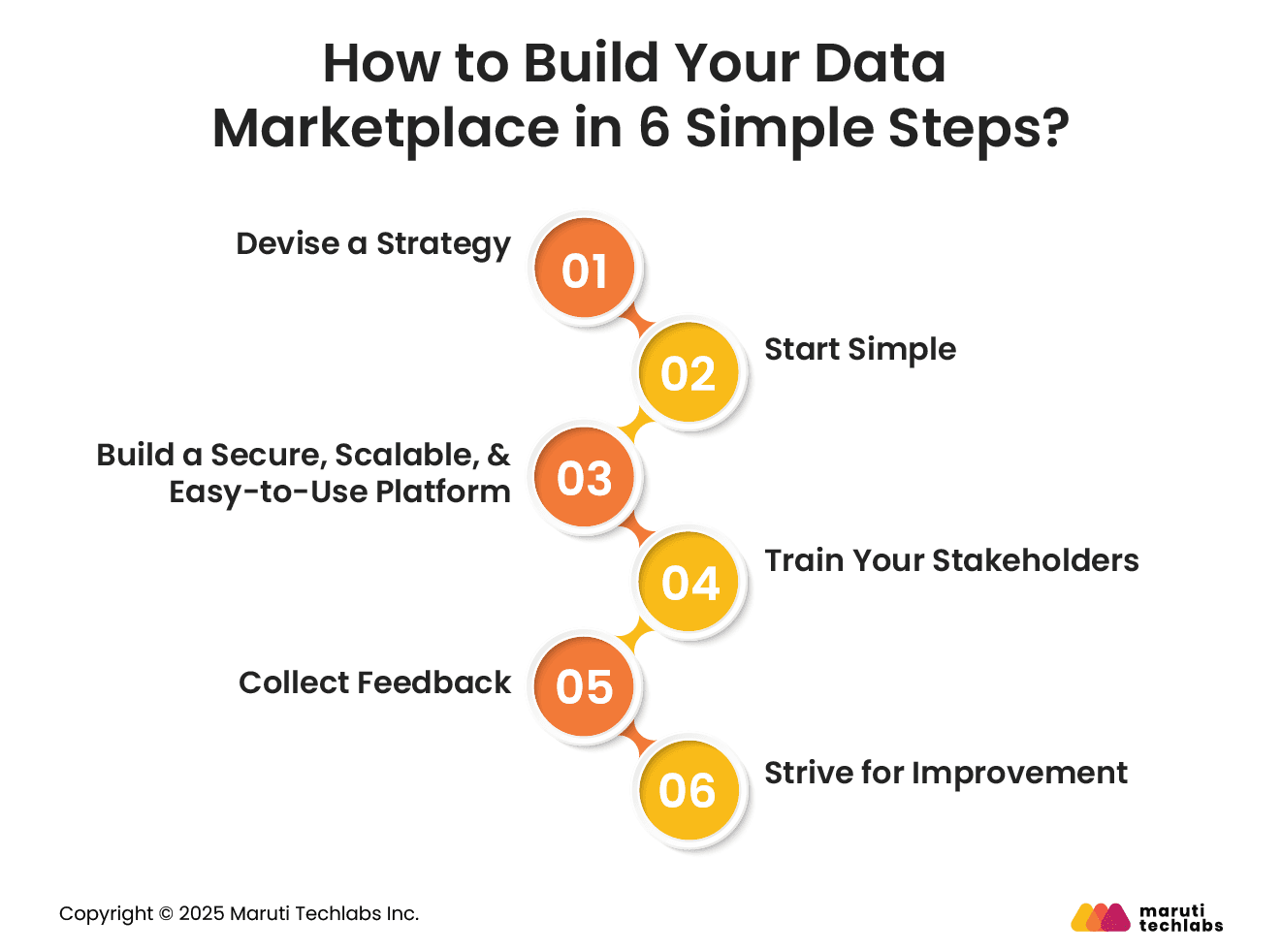

How to Build Your Own Data Marketplace in 2025?






Data has become a distinguishing factor for businesses' success today. Never before has such importance been placed on valuable and actionable insights. This necessity has given rise to groundbreaking solutions like Data Marketplaces.
A report from Grand View Research suggests that the global data marketplace platform market size was estimated at USD 1.49 billion in 2024 and is projected to reach USD 5.73 billion by 2030, growing at a CAGR of 25.2% from 2025 to 2030.
As everything in the world observes a digital shift, so has data trading, and data marketplaces are a classic example of the same. But what are data marketplaces, how do they work, and more importantly, how can you create your data marketplace?
This blog answers all these questions and more, including the value it offers, key requirements, and challenges.
“A data marketplace is a platform that makes it convenient for data providers and consumers to buy and sell trusted datasets. Its advantage is that it simplifies discovering and accessing relevant data.”
It works like any other online marketplace; however, its primary purpose is exchanging data rather than products or services. This model enhances accessibility to varied data sources while facilitating a more transparent exchange of information.
Collecting reliable data is a real challenge. Offering self-service access to data is one way to do this. However, not everyone is tech-savvy, so this process must be intuitive and secure.
Businesses should have a robust data governance framework to protect critical data, ensure regulatory compliance, and maintain quality and accuracy. The framework should also prevent unauthorized access with stringent access controls, encryption, and monitoring mechanisms.
This assures organizations that data is only shared with authorized users who have a real business need to access it. Introducing automation to data sharing with a data marketplace can help overcome this distrust. In addition, it eliminates the hassle of manual data delivery, removes collaboration barriers, and decreases costs and inefficiencies.
A data marketplace must adhere to four key requirements to be successful, functional, and ethical. Let’s observe these requirements in brief.

A data marketplace functions similarly to an e-commerce platform, but it is specifically designed to trade data. Here’s how it functions.
Sellers enlist their datasets in the marketplace, using metadata to describe the content, format, and use cases. The dataset is then made discoverable by categorizing it based on industry, data type, and licensing terms.
Buyers use tools and filters to find the required datasets based on industry or keywords. Many platforms harness AI-based recommendations and ML algorithms to present the most relevant datasets.
Some marketplaces allow buyers to access sample preview datasets to test the data quality before buying. Many of them also certify and validate data to ensure reliability.

When purchasing data, buyers adhere to licensing terms. They can be paid via one-time purchases, pay-per-use, or subscriptions. Some marketplaces automate and secure transactions using blockchain contracts.
Data can be seamlessly integrated into buyers' existing systems and delivered through cloud-based platforms, direct downloads, or APIs. Some marketplaces add convenience by incorporating data directly into business workflows using automated data ingestion and processing tools.
Buyers can subscribe to data updates to ensure they have the latest information. Some platforms provide automated alerts, real-time data streaming, and AI-powered analytics to offer businesses a competitive advantage.
Data marketplaces offer great convenience and flexibility. However, they must deal with confidential information, so privacy and security are of the utmost importance. Here are some prominent challenges organizations face when establishing a data marketplace.

Marketplaces must implement rigorous privacy policies to safeguard the sensitive information in the datasets. Maintaining overall privacy demands that marketplaces comply with data transmission protocols, data protection regulations, and anonymization techniques.
Implementing essential mechanisms to authenticate the quality of datasets is imperative. This includes leveraging reputation systems to instill trust between data providers and consumers, transparency in data provenance, and data validation.
The marketplace’s all-around security should be intact. This includes investing in timely security audits, authentication, and access controls, data encryption at rest and in transit, and protection against cyber attacks.
Creating your marketplace isn’t an easy feat to achieve. But it can be done if you have a clear vision of how to do it. This can be done by following six easy steps.
To begin with, it’s important that your business goals are in congruence with your data marketplace plans. Consider data a valuable resource for determining the exact worth of your collateralized debt obligations (CDOs).
Parallely, monitor operational costs and data quality. This will prepare you for future rules or regulations.
Start by having a practical and straightforward plan. You can begin by creating a marketplace that can show quick results. First, plan a pilot launch focusing on the right products or services. This would require you to look for a skilled team and the right data providers.
Your next move should be to create a minimal viable product (MVP) for your marketplace. This will allow you to validate your idea with its core features without risking all your capital.
If you lack expertise in IT services or need guidance on developing your data marketplace, it’s best to contact an experienced IT service company from the start.
Your platform should facilitate users' easy access to the data they need. To ensure safety on the go, implement access controls and set clear rules for how data can or cannot be used. Your platform should also comply with GDPR rules to protect data privacy and security.
Automate data ingestion to the platform to enhance efficiency. Keep your infrastructure scalable to handle more users and data when your platform expands. Since you have to deal with heaps of data, it's best to invest in cloud solutions or VPS from the start.
Cloud providers offer services that cater to your exact business needs, like daily backups, quick support, performance and security monitoring, and more, as per your SLAs. They also offer the convenience of instant scaling and pay-per-use models to optimize your cloud costs.

Offer all the necessary resources and training to your respective stakeholders. Stakeholders should have complete information about how data trading works on your platform.
This step primarily aims to analyze how your data fares in the marketplace. Collecting feedback to scrutinize the performance of your data products and the overall market is critical.
Continual feedback also helps maintain data quality. It ensures that your data meets user needs and business objectives, maintains the proper standards, and makes informed improvements.
To enhance marketplace features and capabilities, it’s suggested that you continuously examine operations, user engagement, data quality, and results. The aim is to offer the best class service to your customers.
In the coming years, the data business will move towards enhanced accessibility and use for everyone. Here are the main steps in this journey.
Here are the top 5 data marketplaces you should know.
AWS Data Exchange facilitates the secure publishing and monetization of data products for providers. It makes data search, subscription, and use for application and analytics easy for data consumers.
Azure Marketplace offers many data products, including APIs, datasets, and ML models. It promotes data discovery that can be merged with Azure-based applications and workflows.
Google Cloud Public Datasets is a dynamic data marketplace offering various public datasets for analysis. The platform encourages users to implement big data analytics and ML workloads across multiple industries and disciplines without the complexities of data movement.
Snowflake Data Marketplace makes ready-to-query, live datasets accessible from providers across numerous industries. It promotes using a diverse range of data without data copying or movement, offering consumers an efficient solution.
Kaggle, a data science and ML competition platform, has a dataset repository where users can explore and download different datasets shared by the community.
Marketplaces enable secure, compliant, and efficient data sharing, both within organizations and across external partners, encouraging collaboration across teams and industries. They offer benefits such as improved data discoverability, cost savings through reduced data silos, faster access to quality datasets, and the opportunity to generate new revenue streams through data monetization.
However, organizations must weigh these benefits against specific considerations, including data governance, compliance with data privacy regulations, and the technological complexity of marketplace implementation. Choosing the right architecture, access controls, and data cataloging approach is critical for long-term success.
Strategic planning is crucial for enterprises evaluating or building a data marketplace. Start with a simple plan, adopt a phased implementation, train your stakeholders, and implement customer feedback.
Maruti Techlabs brings deep expertise in data engineering and modern data stack implementation. From building ingestion pipelines and managing metadata to implementing access controls and monetization models, MTL ensures your marketplace delivers value while aligning with compliance and business objectives.
Get in touch with us today to build a future-ready data marketplace tailored to your needs.
Snowflake is a cloud data platform that includes the Snowflake Marketplace. It enables users to securely discover, share, and access live, ready-to-query data from third-party providers.
To build a data marketplace, define data sources, ensure governance and compliance, set up secure access controls, integrate cataloging tools, and use cloud infrastructure for scalable data sharing and monetization.
A data catalog helps users find and manage internal data assets. In contrast, a data marketplace enables buying, selling, and sharing data—internally or externally—often with monetization and access controls.
AWS Data Exchange is a marketplace where users can subscribe to third-party datasets from various industries, enabling seamless data access directly into their analytics and data platforms.


